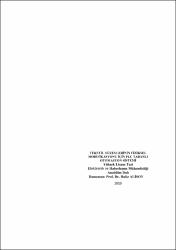| dc.contributor.author | Düzgün, Oğuzhan | |
| dc.date.accessioned | 2020-02-04T07:25:48Z | |
| dc.date.available | 2020-02-04T07:25:48Z | |
| dc.date.issued | 2019 | |
| dc.identifier.uri | https://hdl.handle.net/20.500.11776/3549 | |
| dc.description.abstract | Bu çalışmada, farklı gaz ortamlarında (oksijen, argon ve azot) gerçekleştirilen korona boşalmasının, viskon ve polyester tip elyaf kullanılarak üretilen dokusuz tekstilin fiziksel özellikleri üzerine etkisi incelenmiştir. Deşarj, bir diyafram elektrot konfigürasyonu kullanılarak üretilmiş olup, burada 0.1 x 4 x 32.5 mm'lik (H x W x L) dar yarıklar 26 mm karşılıklı mesafedeki iki elektrot arasına yerleştirilmiştir. Elektrotlar, çift dönen kıvılcım aralığına bağlı olarak darbeli bir HV güç kaynağına bağlanmıştır. Bu çalışmanın birinci bölümünde, viskon ve polyester elyaflı tekstilin sarım kalitesini arttırmak için havasız ortam deşarjı kullanılmıştır. Havasız plazma işleminin mukavemet ve sarım davranışı üzerindeki etkileri, su temas açısı ölçümleri ve çarpma zamanı ölçümleri kullanılarak tanımlanmıştır. Yaşlanma etkisi de incelenmiştir. Yüzey modifikasyonu işlemi argon, oksijen ve azot gazlarının ayrı zamanlarda havasız kabine deşarjı ile korona boşalmasına maruz bıraktırılarak oluşturulmaktadır. Sonuçlar için numuneler mukavemet, hava geçirgenliği, buhar geçirgenliği, renk ölçümü ve boncuklanma testlerine tabi tutulmuştur. Deneyler sonucunda korona boşalmasına maruz bırakılmış kumaş numunelerinin mukavemet, hava ve buhar geçirgenliği özelliklerine etkisi olduğu görülmüştür | en_US |
| dc.description.abstract | In this study, the use of non-woven textiles produced with viscose and polyester fibers as a method of corona discharge in the airless environment using oxygen, argon and nitrogen gases is investigated. The discharge was produced using a diaphragm electrode configuration, where the narrow slits of 0.1 x 4 x 32.5 mm (H x W x L) were placed between two electrodes at a mutual distance of 26 mm. The electrodes were connected to a pulsed HV power source depending on the double rotating spark gap. In the first part of this study, airless discharge is used to increase the winding quality of viscose and polyester fiber textiles. The effects of airless plasma processing on strength and winding behavior are defined using water contact angle measurements and impact time measurements. The effect of aging has also been investigated. The surface modification process is generated by exposing argon, oxygen and nitrogen gases to corona discharge by discharging the airless cabinet at different times. The samples were subjected to strength, air permeability, vapor permeability, color measurement and pilling tests for the results. As a result of the experiments, it was found that the fabric samples subjected to corona discharge had an effect on the strength, air and vapor permeability properties. | en_US |
| dc.language.iso | tur | en_US |
| dc.publisher | Namık Kemal Üniversitesi | en_US |
| dc.rights | info:eu-repo/semantics/openAccess | en_US |
| dc.subject | Dokusuz | en_US |
| dc.subject | Viskon | en_US |
| dc.subject | Polyester | en_US |
| dc.subject | Yüzey Modifikasyonu | en_US |
| dc.subject | Korona Boşalması | en_US |
| dc.subject | Nonwoven | en_US |
| dc.subject | Viscose | en_US |
| dc.subject | Surface Modification | en_US |
| dc.subject | Corona Discharge | en_US |
| dc.title | Tekstil yüzeylerinin fiziksel modifikasyonu için PLC tabanlı otomasyon sistemi | en_US |
| dc.title.alternative | PLC BASED AUTOMATION SYSTEM FOR PHYSICAL MODIFICATION OF TEXTILE SURFACES | en_US |
| dc.type | masterThesis | en_US |
| dc.department | Enstitüler, Fen Bilimleri Enstitüsü, Elektronik ve Haberleşme Mühendisliği Ana Bilim Dalı | en_US |
| dc.relation.publicationcategory | Tez | en_US |



















